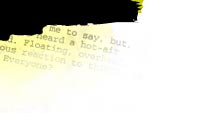 |
The War
A memoir by Marguerite Duras
Adapted by Joanna Settle and Katie Taber
Directed by Joanna Settle
Work-in-Progress Showings
Subterranean Café & Cabaret, Chicago
March 1998
About
the Text:
Marguerite Duras’ World War II memoir The War (La Douleur)
describes her time in Nazi-occupied Paris, when both she and
François Mitterand were active members of the French
resistance. Joanna Settle and Katie Taber discovered that
they were both drawn to Duras' text separately, and fed off
each other's concepts to create a working adaptation of the
memoir.
War is written in
three seemingly concurrent parts, each describing a facet
of Duras' experience during those years. Part I describes
her liaisons with a Nazi officer from whom she hoped to glean
information, and the seemingly unending wait for her husband,
Robert L., to return from Dachau. (Duras' husband was imprisoned
in the concentration camp after his involvement with the resistance).
Settle and Taber chose to focus their adaptation on these
two sections. Each adapted one portion of the memoir,
and Settle directed the entire work-in-progress evening.
Taber appeared in both halves of the adaptation.
About the Production:
The War was performed as a work-in-progress on the second
floor of The Subterranean, a bar in Wicker Park, Chicago.
This donated space, smelling faintly of wine and stale cigarettes,
featured a black and white checkered floor and accents of
woodwork suggesting at once the halls of government agencies
and the culture of the Paris café.
Actors performed the adaptation, (which underwent major revisions
throughout the development process - right up to the performance
day), with scripts in-hand. Company members Katie Taber and
Anne DeAcetis shared the role of Marguerite Duras, personifying
the divergent experiences described in Duras' original.
Also featured were Artistic Associates Kameron Steele (as
Rabier, the Nazi officer), and David Divita (chorus). Choreography
and movement sequences included a 9-minute pause, during which
the audience entirely lost track of time.
Sound design considerations led the way to creating this drawn-out,
saturated sense of experience. Artistic Associate Mike
Frank created his first sound design for the company, performing
live in the Foley tradition: pouring wine into a glass at
a microphone, clinking the plates and silverware of a busy
café, and adding tension with the soft rustle of papers.
|
 |



